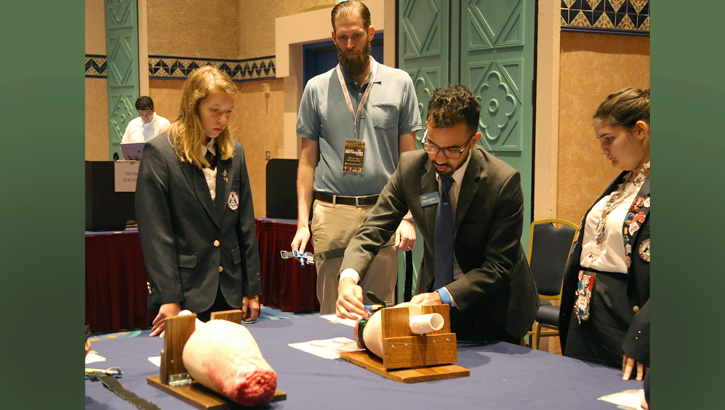
Antibiotic resistance a serious threat that's growing, CDC warns

A bacteriology researcher at the Institute of Medical Research swabs an isolated sample of streptococcus pneumonia in Goroka, Papua New Guinea. The researcher is testing the bacteria to determine if the strain has sensitivity to antibiotics or if it is resistant. (U.S. Air Force photo by Staff Sgt. Marcus Morris)
Doctors prescribe sick patients antibiotic drugs with the specific intent of knocking out the viral, bacterial or fungal infections that put them under the weather. But new research shows microbial pests have learned to fight back.
During a Nov. 13 telephone briefing for news media, both Dr. Robert R. Redfield, the director of the Centers for Disease Control and Prevention (CDC), and Michael Craig of the agency’s Antibiotic Resistance Coordination and Strategy Unit, outlined the situation at hand. Each year, more than 2.8 million infections related to antibiotic resistance take place. More than 35,000 people die from those infections.
Redfield and Craig spoke of the CDC’s newly published white paper on the subject, which reports that nearly 3 million Americans “face an antibiotic-resistant infection.”
The report, titled "Antibiotic Resistance Threats in the United States," identifies 18 known antibiotic-resistant pathogens that must be dealt with before they can proliferate and spread untreatable illnesses. The latest statistics, Redford and Craig said, indicate the problem is far more serious than researchers believed when they prepared the last such report in 2013. Improved measuring methodology has shown that the number of deaths back then was actually twice as high as they believed at the time.
“CDC uses the best data, but [estimates were] conservative at the time,” Craig said.
“It threatens our nation’s health and our global security,” Redfield said. “The good news is we know how to protect ourselves. We’re seeing progress nationwide.”
Related hospital deaths have declined by 18 percent overall and by 30 percent in hospitals alone, Redford said, through the implementation of comprehensive strategies throughout the human and animal health-care professions and agriculture as well.
The CDC is taking a five-pronged approach toward a solution. It entails: infection prevention and control; tracking and sharing data; improving the appropriate use of antibiotics; investment in vaccines, therapeutics and diagnostics; and close monitoring of the environment and sanitation practices.
Within the Military Health System, and particularly at the Uniformed Services University of the Health Sciences, researchers are also taking the issue of antimicrobial resistance seriously.
“Over the last few years we have actively been studying the epidemiology and the outcomes associated with antimicrobial resistance infections in military hospitals,” explained Dr. Allison Malloy, assistant professor of Pediatrics, and a member of the Infectious Disease Faculty, USUHS. “Consistent with the CDC findings, we have found a high mortality associated with some of these infections. Across the Department of Defense facilities, we have implemented programs to help control these infections including active surveillance, rapid pathogen identification and targeted treatment, and data-driven antibiotic stewardship programs.”
For example, the Multidrug-Resistant Organism Repository and Surveillance Network (MRSN), under the Walter Reed Army Institute of Research, coordinates analysis and management of antibiotic resistance across the entire military health system. This helps military treatment facilities share information, optimize standard practices for infection control and patient safety, identify an outbreak of a pathogen earlier, and make more appropriate antibiotic selections for patients. MRSN is part of a DoD-wide effort, Antimicrobial Resistance and Monitoring Research Program (ARMoR), which includes DoD hospital laboratories, clinicians and infection control staff; public health reporting groups; Navy and Air Force public health data collection programs; and national policy groups, with the common goal of managing Service programs monitoring antibiotic-resistant bacteria.
“We will continue to monitor for infections and seek to improve the quality of healthcare provided to military members, their families and retirees,” Dr. Malloy said.
While medical community researchers and clinicians are taking action to counter the bad effects of antibiotic resistance, the CDC offered practical advice that would help average citizens mitigate the risks they face. Here are some:
- When visiting a doctor to treat sickness, ask what could make you feel better rather than request antibiotics specifically. If prescribed antibiotics, use them in the manner in which your provider asks.
- Follow good hygiene practices. Wash your hands, be careful when handling food or caring for animals.
- Get vaccinated.
- Practice safe sex.
- Be vigilant when traveling abroad.
Health care providers can do their part as well, the report said, by following good infection prevention and control practices and being more vigilant when prescribing antibiotics. Providers also should take note of infections and resistance patterns where they work and in their communities.
Military exchanges extinguish vape sales
Article
10/18/2019

The long-term effects of vaping are unknown and not understood
MSMR Vol. 26 No. 10 - October 2019
Report
10/1/2019
A monthly publication of the Armed Forces Health Surveillance Branch. This issue of the peer-reviewed journal contains the following articles: Editorial: The Department of Defense/Veterans Affairs Vision Center of Excellence; Absolute and relative morbidity burdens attributable to ocular and vision-related conditions, active component, U.S. Armed Forces, 2018; Incidence and temporal presentation of visual dysfunction following diagnosis of traumatic brain injury, active component, U.S. Armed Forces, 2006–2017; Incidence and prevalence of selected refractive errors, active component, U.S. Armed Forces, 2001–2018; Incident and recurrent cases of central serous chorioretinopathy, active component, U.S. Armed Forces, 2001–2018
Health agencies investigating severe lung illnesses linked to e-cigarette use
Article
9/12/2019

Thirty-three states report 450 possible cases, six deaths
MSMR Vol. 26 No. 9 - September 2019
Report
9/1/2019
A monthly publication of the Armed Forces Health Surveillance Branch. This issue of the peer-reviewed journal contains the following articles: Editorial: The Department of Defense/Veterans Affairs Vision Center of Excellence; Absolute and relative morbidity burdens attributable to ocular and vision-related conditions, active component, U.S. Armed Forces, 2018; Incidence and temporal presentation of visual dysfunction following diagnosis of traumatic brain injury, active component, U.S. Armed Forces, 2006–2017; Incidence and prevalence of selected refractive errors, active component, U.S. Armed Forces, 2001–2018; Incident and recurrent cases of central serous chorioretinopathy, active component, U.S. Armed Forces, 2001–2018
MSMR Vol. 26 No. 8 - August 2019
Report
8/1/2019
A monthly publication of the Armed Forces Health Surveillance Branch. This issue of the peer-reviewed journal contains the following articles: Modeling Lyme disease host animal habitat suitability, West Point, New York; Incidence, timing, and seasonal patterns of heat illnesses during U.S. Army basic combat training, 2014–2018; Update: Heat illness, active component, U.S. Armed Forces, 2018; Update: Exertional rhabdomyolysis, active component, U.S. Armed Forces, 2014–2018; Update: Exertional hyponatremia, active component, U.S. Armed Forces, 2003–2018
Tick Facts: Dangers at the height of tick season
Article
7/31/2019

Many diseases are transferred to humans by ticks — Lyme is the most common, but several others, described here, are worth knowing about
Stop the Bleed: A battlefield innovation on civilian soil
Article
7/19/2019

Program teaches public how to respond to bleeding emergencies
Influenza
Infographic
7/1/2019

Adminstration of a seasonal flu vaccination. (U.S. Navy photo)
Mononucleosis
Infographic
7/1/2019

A specimen is tested for mononucleosis at the medical clinic on Ellsworth Air Force Base, South Dakota (U.S. Air Force photo)
Zika
Infographic
7/1/2019

Anopheles merus mosquito. (CDC photo by James Gathany)
Psittacosis
Infographic
7/1/2019

Green-winged Macaw. (U.S. Air Force photo)
MSMR Vol. 26 No. 7 - July 2019
Report
7/1/2019
A monthly publication of the Armed Forces Health Surveillance Branch. This issue of the peer-reviewed journal contains the following articles: Modeling Lyme disease host animal habitat suitability, West Point, New York; Incidence, timing, and seasonal patterns of heat illnesses during U.S. Army basic combat training, 2014–2018; Update: Heat illness, active component, U.S. Armed Forces, 2018; Update: Exertional rhabdomyolysis, active component, U.S. Armed Forces, 2014–2018; Update: Exertional hyponatremia, active component, U.S. Armed Forces, 2003–2018
Norovirus
Infographic
6/1/2019

Norovirus Outbreak in Army Service Members, Camp Arifjan, Kuwait, May 2018 In May 2018, an outbreak of gastrointestinal illnesses due to norovirus occurred at Camp Arifjan, Kuwait. The outbreak lasted 14 days, and a total of 91 cases, of which 8 were laboratory confirmed and 83 were suspected, were identified.
Female infertility
Infographic
6/1/2019

Female infertility, active component service women, U.S. Armed Forces, 2013–2018 This report presents the incidence and prevalence of diagnosed female infertility among active component service women. During 2013–2018, 8,744 active component women of childbearing potential were diagnosed with infertility for the first time, resulting in an overall incidence of 79.3 cases per 10,000 person-years (p-yrs).
Cyclosporiasis
Infographic
6/1/2019

Outbreak of Cyclosporiasis in a U.S. Air Force Training Population, Joint Base San Antonio–Lackland, TX, 2018 While bacteria and viruses are the usual causes of gastrointestinal disease outbreaks, 2 Joint Base San Antonio (JBSA)– Lackland, TX, training populations experienced an outbreak of diarrheal illness caused by the parasite Cyclospora cayetanensis in June and July 2018. Cases were identified from outpatient medical records and responses to patient questionnaires.






















.png)











No hay comentarios:
Publicar un comentario